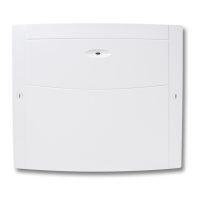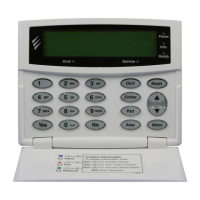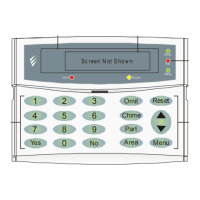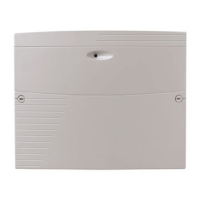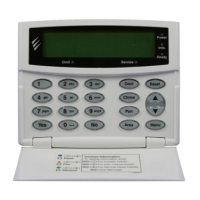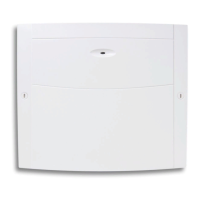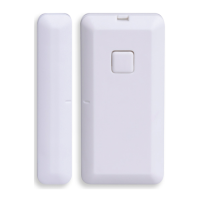Do you have a question about the Texecom Premier 412 and is the answer not in the manual?
Overview of the alarm system components and basic operation principles.
Explains the manual's structure and content for users.
Details the system's capability to monitor fire detection devices.
Describes the system's ability to transmit alarms to a monitoring station.
Explains how the premises are divided into zones and partitions for security.
Details the types and functions of user access codes for system operation.
Discusses the role and placement of remote keypads in the system.
Lists and describes the different types of Premier keypads available.
Illustrates and explains the layout and functions of various keypad models.
Explains the purpose and operation of specific function keys on the keypad.
Describes how to use emergency keys for immediate alarm activation.
Guides users on familiarizing themselves with arming/disarming methods.
Provides instructions on entering access codes correctly.
Explains how to use the Ready light to confirm system status before arming.
Details the steps to arm the system when leaving the premises.
Describes how to arm the system when the premises will be occupied.
Explains how to cancel the arming sequence during the exit delay.
Outlines the procedure to disarm the system upon entering the premises.
Describes how to disarm the system when not in the entry delay period.
Details the steps to disarm the system after an alarm event has occurred.
Explains the automatic Stay arming feature if enabled by the installer.
Covers how to switch from delayed to instant stay modes.
Explains how to revert from instant stay to delayed stay modes.
Covers procedures for arming and disarming specific partitions of the system.
Details how to Away arm one or more selected partitions.
Details how to Stay arm one or more selected partitions.
Details how to disarm one or more selected partitions.
Explains how to temporarily switch the keypad's partition focus.
Covers the process of bypassing zones to prevent alarms.
Step-by-step guide to manually bypass individual zones.
Explains how to re-enable previously bypassed zones.
Describes how to bypass a predefined set of zones simultaneously.
Allows bypassing zones and then arming the system quickly.
Resets standing alarms and latched detectors like smoke detectors.
Allows viewing the zones that caused the last alarm.
Details the procedure to acknowledge new service faults.
Describes how to view existing service faults.
Resets the panel using a unique remote reset number provided by installer/ARC.
Allows users to enable or disable the chime feature for zone violations.
Enables users to change their personal access code.
Stops any ongoing communications to the Alarm Receiving Centre.
Allows viewing the system's event log on LCD keypads.
Covers menus for programming user access codes and permissions.
Provides access to system testing and diagnostic utilities.
Explains how to program text messages for LCD keypads.
Defines access permissions for partitions and basic functions like arming/disarming.
Configures options such as one-time codes and door strike activation.
Sets advanced permissions like engineer access and local partition control.
Describes assigning new users, their access codes, and general attributes.
Detailed explanation of User Options 1 for managing user access to partitions and functions.
Detailed explanation of User Options 2 for configuring specific user behaviours and permissions.
Detailed explanation of User Options 3 for advanced user controls and permissions.
How to assign text labels to users for LCD keypads.
Guides performing a walk test to verify zone functionality.
Tests audio outputs and system components.
Initiates a test transmission to the Alarm Receiving Centre.
Authorizes remote access for programming and diagnostics.
Initiates a call back for remote access to the control panel.
Sets the system's internal clock for accurate event logging.
Sets the system's date for accurate event logging.
Programs custom text for the banner display on LCD keypads.
Sends the last 100 system events to a connected printer.
Describes how the system behaves during a fire alarm event.
How to silence the fire alarm bell or siren.
Procedure for resetting smoke detectors after an event.
Recommendations for conducting a home safety audit to minimize fire risks.
Guidance on developing and rehearsing a family fire escape plan.
Provides essential maintenance tips for the alarm system and its components.
Defines key terms used throughout the user manual.
Section to record control panel model and location details.
Records details for each installed keypad, including location and partition assignment.
Records programmed timer settings for various system delays and durations.
Records details for each protected zone, including text and partition assignments.
Records user details, including name, assigned partitions, and permissions.
Overview of the alarm system components and basic operation principles.
Explains the manual's structure and content for users.
Details the system's capability to monitor fire detection devices.
Describes the system's ability to transmit alarms to a monitoring station.
Explains how the premises are divided into zones and partitions for security.
Details the types and functions of user access codes for system operation.
Discusses the role and placement of remote keypads in the system.
Lists and describes the different types of Premier keypads available.
Illustrates and explains the layout and functions of various keypad models.
Explains the purpose and operation of specific function keys on the keypad.
Describes how to use emergency keys for immediate alarm activation.
Guides users on familiarizing themselves with arming/disarming methods.
Provides instructions on entering access codes correctly.
Explains how to use the Ready light to confirm system status before arming.
Details the steps to arm the system when leaving the premises.
Describes how to arm the system when the premises will be occupied.
Explains how to cancel the arming sequence during the exit delay.
Outlines the procedure to disarm the system upon entering the premises.
Describes how to disarm the system when not in the entry delay period.
Details the steps to disarm the system after an alarm event has occurred.
Explains the automatic Stay arming feature if enabled by the installer.
Covers how to switch from delayed to instant stay modes.
Explains how to revert from instant stay to delayed stay modes.
Covers procedures for arming and disarming specific partitions of the system.
Details how to Away arm one or more selected partitions.
Details how to Stay arm one or more selected partitions.
Details how to disarm one or more selected partitions.
Explains how to temporarily switch the keypad's partition focus.
Covers the process of bypassing zones to prevent alarms.
Step-by-step guide to manually bypass individual zones.
Explains how to re-enable previously bypassed zones.
Describes how to bypass a predefined set of zones simultaneously.
Allows bypassing zones and then arming the system quickly.
Resets standing alarms and latched detectors like smoke detectors.
Allows viewing the zones that caused the last alarm.
Details the procedure to acknowledge new service faults.
Describes how to view existing service faults.
Resets the panel using a unique remote reset number provided by installer/ARC.
Allows users to enable or disable the chime feature for zone violations.
Enables users to change their personal access code.
Stops any ongoing communications to the Alarm Receiving Centre.
Allows viewing the system's event log on LCD keypads.
Covers menus for programming user access codes and permissions.
Provides access to system testing and diagnostic utilities.
Explains how to program text messages for LCD keypads.
Defines access permissions for partitions and basic functions like arming/disarming.
Configures options such as one-time codes and door strike activation.
Sets advanced permissions like engineer access and local partition control.
Describes assigning new users, their access codes, and general attributes.
Detailed explanation of User Options 1 for managing user access to partitions and functions.
Detailed explanation of User Options 2 for configuring specific user behaviours and permissions.
Detailed explanation of User Options 3 for advanced user controls and permissions.
How to assign text labels to users for LCD keypads.
Guides performing a walk test to verify zone functionality.
Tests audio outputs and system components.
Initiates a test transmission to the Alarm Receiving Centre.
Authorizes remote access for programming and diagnostics.
Initiates a call back for remote access to the control panel.
Sets the system's internal clock for accurate event logging.
Sets the system's date for accurate event logging.
Programs custom text for the banner display on LCD keypads.
Sends the last 100 system events to a connected printer.
Describes how the system behaves during a fire alarm event.
How to silence the fire alarm bell or siren.
Procedure for resetting smoke detectors after an event.
Recommendations for conducting a home safety audit to minimize fire risks.
Guidance on developing and rehearsing a family fire escape plan.
Provides essential maintenance tips for the alarm system and its components.
Defines key terms used throughout the user manual.
Section to record control panel model and location details.
Records details for each installed keypad, including location and partition assignment.
Records programmed timer settings for various system delays and durations.
Records details for each protected zone, including text and partition assignments.
Records user details, including name, assigned partitions, and permissions.
| Type | Control Panel |
|---|---|
| Zones | 4 |
| Keypads | Up to 8 |
| Part Sets | 4 |
| Communication | IP, GSM |
| Battery Backup | 7Ah |
| Compatible with | Texecom peripherals |
| Dimensions | 80mm |


